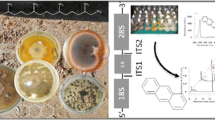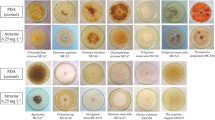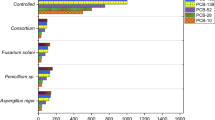Abstract
One hundred and two basidiomycete strains (93 species in 41 genera) that prefer a soil environment were examined for screening of 1,1,1-trichloro-2,2-bis(4-chlorophenyl)ethane (DDT) biodegradation. Three strains within two litter-decomposing genera, Agrocybe and Marasmiellus, were selected for their DDT biotransformation capacity. Eight metabolites; 1,1-dichloro-2,2-bis(4-chlorophenyl)ethane (DDD), two monohydroxy-DDTs, monohydroxy-DDD, 2,2-dichloro-1,1-bis(4-chlorophenyl)ethanol, putative 2,2-bis(4-chlorophenyl)ethanol and two unidentified compounds were detected from the culture with Marasmiellus sp. TUFC10101. A P450 inhibitor, 1-ABT, inhibited the formation of monohydroxy-DDTs and monohydroxy-DDD from DDT and DDD, respectively. These results indicated that oxidative pathway which was catalyzed by P450 monooxygenase exist beside reductive dechlorination of DDT. Monohydroxylation of the aromatic rings of DDT (and DDD) by fungal P450 is reported here for the first time.



Similar content being viewed by others
References
Aislable JM, Richards NK, Boul HL (1997) Microbial degradation of DDT and its residues: a review. NZ J Agric Res 40:269–282
Binder M, Hibbett DS, Larsson KH, Larsson E, Langer E, Langer G (2005) The phylogenetic distribution of resupinate forms across the major clades of mushroom-forming fungi (Homobasidiomycetes). Syst Biodivers 3:113–157
Bumpus JA, Aust SD (1987) Biodegradation of DDT by the white rot fungus Phanerochaete chrysosporium. Appl Environ Microbiol 53:2001–2007
Bumpus JA, Powers RH, Sun T (1993) Biodegradation of DDE (1,1-dichloro-2,2-bis (4-chlorophenyl)ethane) by Phanerochaete chrysosporium. Chemosphere 19:1387–1398
Fernando T, Aust SD, Bumpus JA (1989) Effects of culture parameters on DDT [1,1,1-trichloro-2,2-bis (4-chlorophenyl)ethane] biodegradation by Phanerochaete chrysosporium. Chemosphere 19:1387–1398
Foght J, April T, Bigga K, Aislabie J (2001) Bioremediation of DDT-contaminated soils: a review. Bioremediat J 53:225–246
Gardes M, Bruns TD (1993) ITS primers with enhanced specificity for basidiomycetous—application to the identification of mycorrhizae and rusts. Mol Ecol 2:113–118
Hay AG, Focht DD (1998) Cometabolism of 1,1-dichloro-2,2-bis (4-chlorophenyl)ethane by Pseudomonas acidovorans M3GY grown on biphenyl. Appl Environ Microbiol 64:2141–2146
Hay AG, Focht DD (2000) Transformation of 1,1-dichrolo-2,2-(4-chrolophenyl)ethane (DDD) by Ralstonia eutropha strain A5. FEMS Microb Ecol 31:249–253
Huang Y, Zhao X, Luan S (2007) Uptake and biodegradation of DDT by 4 Ectomycorrhizal fungi. Sci Total Environ 385:235–241
Jones KC, de Voogt P (1999) Persistent organic pollutants (POPs): state of the science. Environ Pollut 100:209–221
Kamanavalli CM, Ninnekar HZ (2004) Biodegradation of DDT by a Pseudomonas species. Curr Microbiol 48:10–13
Kamei I, Kondo R (2005) Biotransformation of dichloro-, trichloro-, and tetrachlorodibenzo-p-dioxin by the white-rot fungus Phlebia lindtneri. Appl Microbiol Biotechnol 68:560–566
Lang E, Eller G, Zadrazil F (1997) Lignocellulose decomposition and production of ligninolytic enzymes during interaction of white rot fungi with soil microorganisms. Microb Ecol 34:1–10
Macalady DL, Tratnyek PG, Grundl TJ (1986) Abiotic reduction reactions of anthropogenic organic chemicals in anaerobic systems: a critical review. J Contam Hydro 1:1–28
Maekawa N, Suhara H, Kinjo K, Kondo R, Hoshi Y (2005) Haloaleurodiscus mangrovei gen. sp. nov. (Basidiomycotina) from mangrove forests in Japan. Mycol Res 109:825–832
Martens R, Zadrazil F (1998) Screening of white-rot fungi for their ability to mineralize polycyclic aromatic hydrocarbons in soil. Folia Microbiol 43:97–103
Menzer RE, Nelson JO (1991) Water and soil pollutants. In: Amdur M, Doull J, Klaassen CD (eds) Casarett and Doull’s toxicology: the basic science of poisons, 4th edn. Pergamon Press, New York, pp 872–902
Moncalvo JM, Lutzoni FM, Rehner SA, Johonson J, Vilgalys R (2000) Phylogenetic relationships of agaric fungi based on nuclear large subunit ribosomal DNA sequences. Syst Biol 49:278–305
Mori T, Kondo R (2002) Oxidation of chlorinated dibenzo-p-dioxin and dibenzofran by white-rot fungus Phlebia lindtneri. FEMS Microbiol Lett 216:223–227
Nadeau LJ, Menn FM, Breen A, Sayler GS (1994) Aerobic degradation of 1,1,1-trichloro-2,2-bis(4-chlorophenyl)ethane (DDT) by Alcaligens eutrophus A5. Appl Environ Microbiol 60:51–55
Pfaender FK, Alexander M (1972) Extensive microbial degradation of DDT to DDD by Proteus vulgaris, a bacterium isolated from the intestinal flora of a mouse. Nature 205:621–622
Purunomo AS, Kamei I, Kondo R (2008) Degradation of 1,1,1-trichloro-2,2-bis (4-chlorophenyl)ethane (DDT) by brown-rot fungi. J Biosci Bioeng 105:614–621
Rochkind ML, Blackburn JW, Sayler GS (1986) Microbial decomposition of chlorinated aromatic compounds. EPA/600/2-86/090, U.S. Environmental Protection Agency, Cincinnati
Simonich SL, Hites RA (1995) Global distribution of persistent organochlorine compounds. Science 269:1851–1854
Subba-Rao RV, Alexander M (1977) Products formed from analogues of DDT metabolites by Pseudomonas putida. Appl Environ Microbiol 33:101–108
Turusov V, Rakitsky V, Tomatis L (2002) Dichlorodiphenyltrichloroethane (DDT): ubiquity, persistence, and risks. Environ Health Perspect 110:125–128
Wedemeyer G (1996) Dechlorination of DDT by Aerobacter aerognes. Science 152:647–652
Acknowledgments
We are grateful to Eiji Nagasawa (The Tottori Mycological Institute and Tottori University) for his identification of the basidiomycetes researched. This work was supported by the Grant-in-Aid for the Global COE Program “Advanced Utilization of Fungus/Mushroom Resources for Sustainable Society in Harmony with Nature” from the Ministry of Education, Culture Sports, Science and Technology (MEXT) of Japan.
Author information
Authors and Affiliations
Corresponding author
Rights and permissions
About this article
Cite this article
Suhara, H., Adachi, A., Kamei, I. et al. Degradation of chlorinated pesticide DDT by litter-decomposing basidiomycetes. Biodegradation 22, 1075–1086 (2011). https://doi.org/10.1007/s10532-011-9464-2
Received:
Accepted:
Published:
Issue Date:
DOI: https://doi.org/10.1007/s10532-011-9464-2




